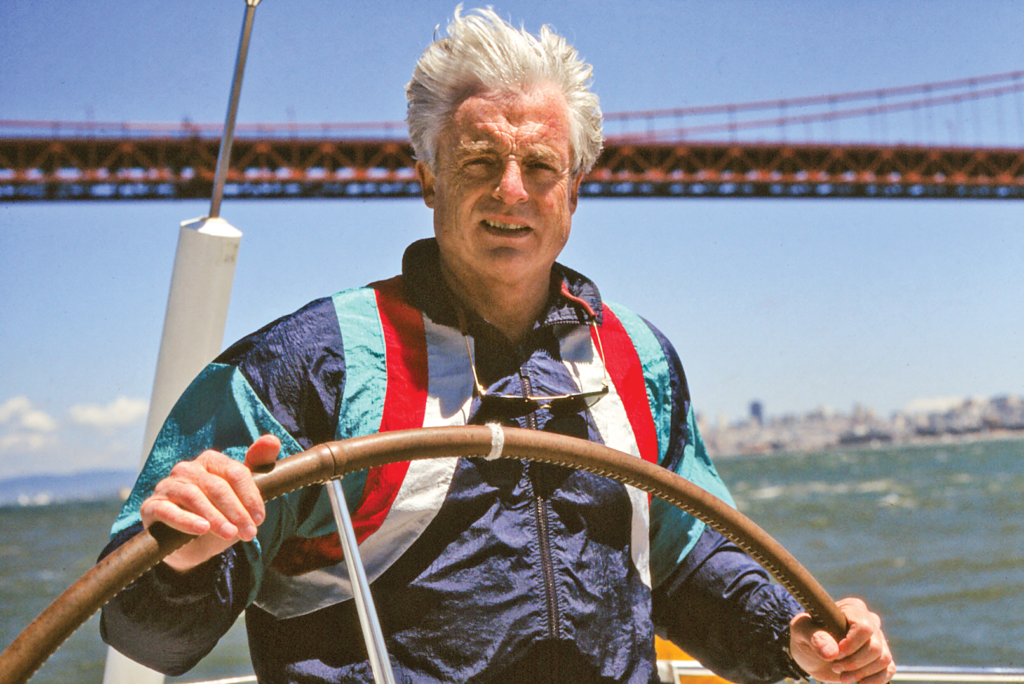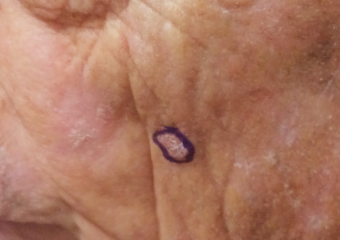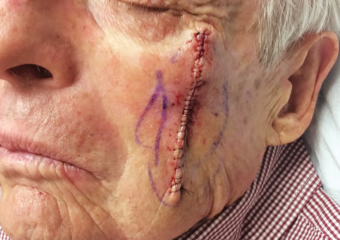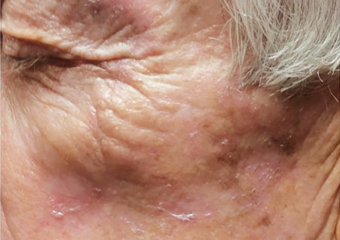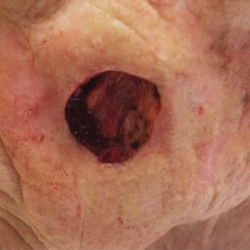Sailing Away: Leo J. McCarthy, MD, loves being active outside — here, sailing under the Golden Gate Bridge on San Francisco Bay. Photos courtesy of Leo J. McCarthy, MD
Passion for the great outdoors has been both a blessing and a curse for Leo J. McCarthy, MD. Nature has given him so much that is positive, but the sun exposure led to many skin cancers, too.
By Elizabeth Sutton, MD, and C. William Hanke, MD, MPH
Nature was Leo McCarthy’s playground during his childhood in the Midwest, an outlet for his athletic prowess throughout his school years and a relief from the intensity of his service as a field surgeon in Vietnam. Along the way, he found jobs that allowed him to work outside, too. He had no idea till later that ultraviolet (UV) radiation from the sun was damaging his skin and leading to serious consequences. His Irish ancestry skin type added to his risks, and he had the sunburns to show for it. Medical school (and visits to a dermatologist) shed some light. The renowned pathologist, expert in transfusion medicine and pioneer in AIDS research shared his story with two of the dermatologists who have treated him.
How would you describe your childhood in Omaha, Nebraska — and your sun exposure during those years?
Dr. McCarthy: I grew up outside. As a youngster, I spent most of my time playing outdoors. One of my aunts owned a cottage on Lake Okoboji in Iowa. She took me up there in the summers. I loved the water and sun, learned to fish, swim and drive motorboats. Like most boys my age then, I never wore sun lotion; I hadn’t even heard of it.
Did your love of the outdoors influence your job choices from an early age?
Yes. While growing up, I took on many jobs that required me to be outside, including newspaper delivery and shoveling snow. As an adolescent, I detasseled corn in Iowa for three summers. I wore a brimmed straw hat, but it was too loosely woven to block the UV rays. I got many sunburns. When I was in high school, I worked as a car hop, and then as a delivery boy for a drugstore.
The summer after high school, I got a job at a lodge on the north rim of the Grand Canyon working as a wood boy, which included cleaning out fireplaces, chopping wood and bringing new firewood and kindling to the cabins. For an adventure, in one 24-hour period, some coworkers and I literally ran 25 miles down from the canyon’s north rim, rested by the roaring Colorado River, then began the arduous ascent up to the south rim on multiple switchbacks, sweating bullets, had breakfast at the El Tovar Hotel, then hitchhiked the 300 miles back. There was only one bridge across the canyon, but luckily, we got good rides. I spent many clear evenings sitting on the edge of the canyon wondering if I should pursue medicine. Somehow, I believed I should … I’m glad I did. The rest is history.
What did you love about being an athlete?

Collegiate track star: McCarthy is “in the zone” as he sprints to the finish line in a meet at Creighton University.
Sports always interested me, and God gave me a gift: I was born with speed! I played little league football when I was in seventh grade and again in high school. I was on the Creighton Prep high school football team that was inducted into the Nebraska Hall of Fame for an undefeated season. I learned to play handball at Creighton Prep. We played with no gloves or shoes, and the ball was hard as a rock. I was on my high school track team and also ran track in college, where I won multiple medals. I remember one beautiful day when my legs were loose and I had never felt that good. I was “in the zone,” as they say, and I won the 100-yard dash so easily no one else was even close. Later I learned it was a Creighton stadium record: 9.7 seconds on a cinder track. The record still stands because later, the stadium was torn down.
Did you stay indoors more in the winters?
No. In my early 20s, I took up skiing, which I loved. I skied annually for over 20 years. I really enjoyed being outside and being in the sun, especially in the winter. Almost every winter I also went to Mexico for a week.
Tell us about your time serving in Vietnam and your sun exposure while there.
I got a lot of sun in Vietnam — it was hotter than hell. Then, during the monsoon season for about three months, it rained daily. I lived in a leaky World War II surplus tent with four other doctors. We lived out in the bush and had no floor, only mud. If you wanted a shower, you had to fill and carry a heavy container of water, get a ladder and hang it up before showering outside with no privacy at all.
I had some dumbbells and would take my shirt off outside to lift weights. I jogged along Highway 1 by the ocean without my shirt, too. It was probably stupid since we were in a combat zone. But I was ignorant to the risks and merely wanted to abate my overwhelming boredom between the times the wounded were helicoptered to us. I once tried running on the beach, but my feet got blisters because the sand was so hot. I made an outdoor handball court in Vietnam. We played whenever we were able. I often snorkeled off the coast.

In the Navy: McCarthy in Navy dress whites, 1965, and blowing off steam in the outdoor handball court during his service in Vietnam.
You had to go inside sometimes. So, switching gears, what was most rewarding about your career at Indiana University?
As a pathologist there, I performed numerous autopsies. My appearance in court for criminal cases was required at times. I was the director of the University’s blood bank and became an expert in transfusion medicine [the practice of transfusing blood and blood products]. I was the second in our state to obtain my boards in this new specialty. I taught second-year medical students and developed the first accredited transfusion medicine fellowship in the state. It was most challenging to work in my field during the AIDS crisis, especially at the beginning when there was voluminous misinformation publicized about its cause. Transfusion was never the main cause of HIV. Many people were frightened to even donate blood.
While you mainly worked with blood as a physician, apparently you learned quite a bit about skin cancers along the way. How many have you had?
I have had over 40 skin cancers, including basal cell carcinomas (BCCs), squamous cell carcinomas (SCCs) and one melanoma. Fortunately, that was caught early and had not spread (metastasized). I have had skin cancers on my face, neck, trunk, arms and legs and have undergone extensive surgical procedures to treat them.
In 2017 I had a large golf ball-sized SCC on my left cheek. It was treated by my Mohs surgeon in Indiana, Dr. C. William Hanke. He removed the tumor completely and performed the reconstruction the same day. The scar is undetectable. In August of 2021, I had a large, aggressive SCC on the left side of my neck that was the diameter of a tennis ball. Dr. Hanke performed Mohs surgery, achieved tumor clearance, meaning there were no remaining cancer cells detected on the margins — and this one also healed beautifully. These are just two stories from my many skin cancer surgeries.
Paying the Price: In 2017 Dr. McCarthy had Mohs surgery on a large SCC on his cheek. Dr. Hanke was able to remove all the cancer and reconstruct the wound, which healed well. To see the large surgical wound where the tumor was removed, click below.
I believe that my numerous skin cancers were due to my genetics (we Irish lack melanin, the pigmentation in skin that can be protective) plus the extensive sun exposure I experienced throughout my life.
What would you like young athletes and others who love the outdoors to learn from your experience?
My advice would be to avoid the midday sun and apply high SPF sunscreen and use it frequently. I only started using sun protection and sun avoidance after my first few skin cancers. I wish I had started protecting my skin sooner!
Elizabeth Sutton, MD, is a dermatologist who is completing a fellowship in Mohs micrographic surgery and dermatologic oncology under the mentorship of C. William Hanke, MD, at the Laser and Skin Surgery Center of Indiana and Ascension St. Vincent Hospital, Indianapolis.
C. William Hanke, MD, MPH, is a Mohs surgeon at the Laser and Skin Surgery Center of Indiana. A senior vice president of The Skin Cancer Foundation and a member of its Amonette Circle, he has also served as president of 13 professional societies.


